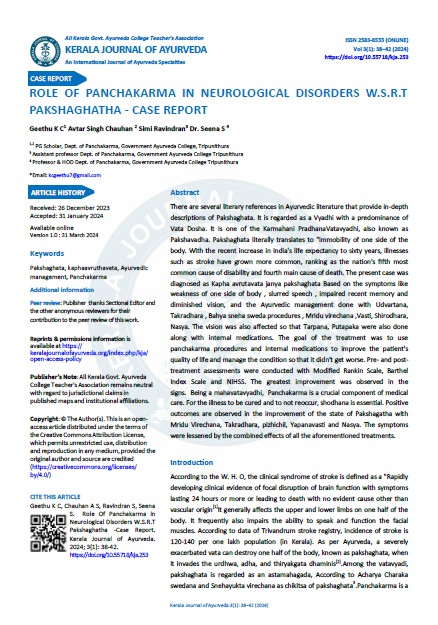ROLE OF PANCHAKARMA IN NEUROLOGICAL DISORDERS W.S.R.T PAKSHAGHATHA - CASE REPORT
DOI:
https://doi.org/10.55718/kja.253Keywords:
Pakshaghata, Ayurvedic management, kaphaavruthavata, PanchakarmaAbstract
There are several literary references in Ayurvedic literature that provide in-depth descriptions of Pakshaghata. It is regarded as a Vyadhi with a predominance of Vata Dosha. It is one of the Karmahani PradhanaVatavyadhi, also known as Pakshavadha. Pakshaghata literally translates to "immobility of one side of the body. With the recent increase in India's life expectancy to sixty years, illnesses such as stroke have grown more common, ranking as the nation's fifth most common cause of disability and fourth main cause of death. The present case was diagnosed as Kapha avrutavata janya pakshaghata Based on the symptoms like weakness of one side of body , slurred speech , impaired recent memory and diminished vision, and the Ayurvedic management done with Udvartana, Takradhara , Bahya sneha sweda procedures , Mridu virechana ,Vasti, Shirodhara, Nasya. The vision was also affected so that Tarpana, Putapaka were also done along with internal medications. The goal of the treatment was to use panchakarma procedures and internal medications to improve the patient's quality of life and manage the condition so that it didn't get worse. Pre- and posttreatment assessments were conducted with Modified Rankin Scale, Barthel Index Scale and NIHSS. The greatest improvement was observed in the signs. Being a mahavatavyadhi, Panchakarma is a crucial component of medical care. For the illness to be cured and to not reoccur, shodhana is essential. Positive outcomes are observed in the improvement of the state of Pakshagatha with Mridu Virechana, Takradhara, pizhichil, Yapanavasti and Nasya. The symptom
References
KAho, P Harmsen, et.al. Cerebrovascular disease in the community: results of a WHO collaborative study. Bull World Health Organ (1980); 58: 113–130. PMID: 6966542.
YadavajiTrikamji (editor). Commentary: Ayurveda Dipika on CharakaSamhita of Charaka. Chaukhambha publishers, Varanasi. Reprint edition (2008). Nidanasthana, 21/3 P.60-63.
KRSrikanthamurthy. Susrutasamhita, English translation. Chaukhambhaorientalia, Varanasi. Edition (2008) Nidanasthana 1/63. P.462.
National Institutes of Health >National Institute of Neurological Disorders and Stroke>StrokeScale. https://www.ninds.nih.gov/ sites/default/files/NIH_Stroke_Scale_Booklet.pdf
KantiKar P. Udvatana-samvahanvis-a-vis effleurage.IntAyurvedic Med J. (2015); Vol 3, Issue 6. P. 2320
Yadavjitrikamji Acharya. CharakaSamhita with the Ayurveda Dipika commentary of Chakrapanidatta, Chaukhamba Krishnadas Academy, Varanasi, Reprinted (2006), Siddisthana 3/36. P. 122.





